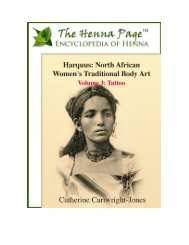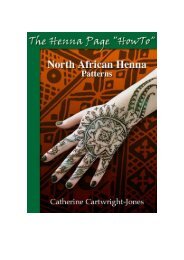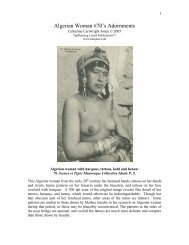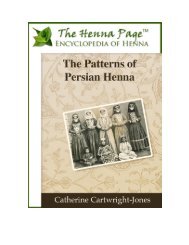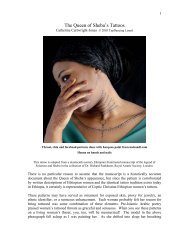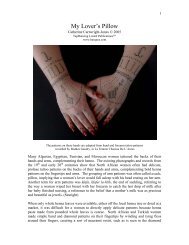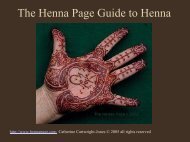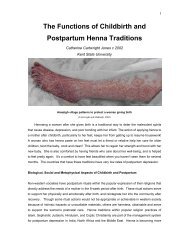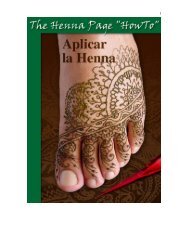Chapter II - The Henna Page
Chapter II - The Henna Page
Chapter II - The Henna Page
You also want an ePaper? Increase the reach of your titles
YUMPU automatically turns print PDFs into web optimized ePapers that Google loves.
2<br />
DEVELOPING GUIDELINES ON HENNA:<br />
A GEOGRAPHICAL APPROACH<br />
<strong>Chapter</strong> <strong>II</strong>:<br />
Criteria for a Systematic Investigation of <strong>Henna</strong><br />
Evidence of henna body art must be based on directly observing henna’s characteristics,<br />
and extending these observations into the past, to that which we cannot directly observe.<br />
We observe that henna leaves a rusty-red stain on skin. <strong>Henna</strong>’s dye is lawsone, the redorange<br />
dye molecule. Lawsone stains skin and other keratin. <strong>The</strong> initial stain is orange,<br />
and that may oxidize to dark red, to brown, and nearly black. Human skin is presumably<br />
the same now as it was 8,000 years ago. <strong>The</strong> henna plant and its lawsone molecule are<br />
presumably the same now as it was 8,000 years ago. If henna leaves a brick colored stain<br />
on hands and feet now, henna should have left a brick colored stain on hands and feet<br />
consistently since the late Neolithic.<br />
Copyright 2006 Catherine Cartwright-Jones<br />
Published by <strong>Henna</strong> <strong>Page</strong> Publications, a division of TapDancing Lizard LLC<br />
4237 Klein Ave. Stow, Ohio 44224 USA All rights reserved.
3<br />
<strong>The</strong> first set of criteria would be to determine whether there are any eliminating factors<br />
that would preclude the possibility of the markings being made by henna. <strong>The</strong> second set<br />
of criteria for evaluating the evidence of henna body adornment would be to demonstrate<br />
that the henna plant could have been available to make the stain. This is determined by<br />
comparing the location of the artifact to a climate zone suitable for henna. <strong>The</strong> third set of<br />
criteria would be that the appearance of the markings would have to be consistent in color<br />
and placement with henna body art. <strong>Henna</strong> stains differently across the geography of the<br />
body, and henna markings are usually placed in the optimal stain areas, the hands and<br />
feet. <strong>Henna</strong> stains have a specific color range, and representations would be expected to<br />
fall within that range. <strong>The</strong> fourth set of criteria would be contextual evidence from<br />
written accounts of henna use, cultural associations of henna use and other forms of body<br />
art that can be used to support or negate henna as the probable source of the body<br />
markings.<br />
If there are no “negatives”, and there are criteria about the artifact consistent with henna,<br />
that sets an artifact in the range of being “possibly henna”. Since there are other sources<br />
of red-brown body markings, all “possibles” from this list must be further examined to<br />
support the probability that the markings were made with henna rather than a cosmetic<br />
with similar appearance. Taken together, these sets of criteria should provide a “sieve”<br />
for artifacts with body markings that would support or eliminate the interpretation of<br />
body markings as either representing henna, or representing another form of body art.<br />
<strong>The</strong> “positives” then can be positioned to construct historical geographies of henna.<br />
Copyright 2006 Catherine Cartwright-Jones<br />
Published by <strong>Henna</strong> <strong>Page</strong> Publications, a division of TapDancing Lizard LLC<br />
4237 Klein Ave. Stow, Ohio 44224 USA All rights reserved.
4<br />
<strong>The</strong> <strong>Henna</strong> Plant: Lawsonia Inermis<br />
Figure 15: Three-year-old henna plant, 1 m tall; branches (Cartwright-Jones, 2004 and<br />
2005)<br />
Division: Magnoliophyta<br />
Class: Magnoliopsida<br />
SubClass: Rosidae<br />
Order: Myrtales<br />
Family: Lythraceae<br />
Copyright 2006 Catherine Cartwright-Jones<br />
Published by <strong>Henna</strong> <strong>Page</strong> Publications, a division of TapDancing Lizard LLC<br />
4237 Klein Ave. Stow, Ohio 44224 USA All rights reserved.
5<br />
To establish criteria for henna, the plant must be defined. <strong>Henna</strong>, Lawsonia inermis, is a<br />
tall shrub or small tree, 2 – 6 m high. It is glabrous, multibranched with spine tipped<br />
branchlets. Leaves are opposite, entire, glabrous, sub sessile, elliptical, and broadly<br />
lanceolate (1.5 – 5.0 CM x 0.5 – 2 cm, acuminate, having depressed veins on the dorsal<br />
surface (Kumar, Singh, & Singh, 2005).<br />
Figure 16: Lawsonia inermis leaves and seeds (Cartwright-Jones, 2005)<br />
Lawsone resides in the leaves and is in the highest quantities in the petiole.<br />
Figure 17: A high-resolution scan of a newly budded henna leaf showing red lawsone<br />
concentrated in the petiole (Cartwright-Jones, 2005)<br />
Copyright 2006 Catherine Cartwright-Jones<br />
Published by <strong>Henna</strong> <strong>Page</strong> Publications, a division of TapDancing Lizard LLC<br />
4237 Klein Ave. Stow, Ohio 44224 USA All rights reserved.
6<br />
<strong>The</strong> highest lawsone content is in the new growth of leaves following an extended period<br />
of heat and drought, then a brief flush of rain (Roy, Singh, & Tewari, 2005). During the<br />
onset of precipitation intervals, the plant grows rapidly; putting out new shoots, then<br />
growth slows. <strong>The</strong> leaves gradually yellow and fall during prolonged dry or cool<br />
intervals.<br />
Figure 18: Stages of henna leaf development: new growth, one month old, and three<br />
months old (Cartwright-Jones, 2005)<br />
Figure 19: <strong>Henna</strong> seeds (Cartwright-Jones, 2005)<br />
<strong>The</strong> seeds are three mm across, angular with a thick seed coat (Kumar, Singh & Singh,<br />
2005). <strong>Henna</strong> seeds are not difficult to germinate, but require soaking and moisture<br />
maintenance during initial growth. In the wild, birds feasting on henna berries at one<br />
Copyright 2006 Catherine Cartwright-Jones<br />
Published by <strong>Henna</strong> <strong>Page</strong> Publications, a division of TapDancing Lizard LLC<br />
4237 Klein Ave. Stow, Ohio 44224 USA All rights reserved.
7<br />
wadi or oasis propagate henna when they migrate to another oasis and excrete seed.<br />
<strong>Henna</strong> farmers propagate by rooting cuttings in a riverbank or nursery, a more reliable<br />
method than planting seed (Singh, Jindal & Singh, 2005).<br />
Figure 20: <strong>Henna</strong> seeds sprouting (Foster, 2004)<br />
<strong>Henna</strong> flowers have four sepals and a 2 mm calyx tube with three mm spread lobes.<br />
Petals are obvate, white or red stamens inserted in pairs on the rim of the calyx tube.<br />
Ovary is four celled, style up to five mm long and erect. Fruits are small, brownish<br />
capsules, four to eight mm in diameter, with 32 to 49 seeds per fruit, and open irregularly<br />
into four splits (Kumar, Singh & Singh, 2005). Lawsone content in leaves is negatively<br />
associated with the number of seeds in the fruits (Singh, Jindal & Singh, 2005).<br />
Copyright 2006 Catherine Cartwright-Jones<br />
Published by <strong>Henna</strong> <strong>Page</strong> Publications, a division of TapDancing Lizard LLC<br />
4237 Klein Ave. Stow, Ohio 44224 USA All rights reserved.
8<br />
Figure 21: <strong>Henna</strong> fruits (Abid and Co, 2004)<br />
Figure 22: <strong>Henna</strong> Flowers (Musselman, 2005)<br />
Copyright 2006 Catherine Cartwright-Jones<br />
Published by <strong>Henna</strong> <strong>Page</strong> Publications, a division of TapDancing Lizard LLC<br />
4237 Klein Ave. Stow, Ohio 44224 USA All rights reserved.
9<br />
Figure 23: <strong>Henna</strong> flowers in four colors, white, pink, yellow and dark rose (Cartwright-<br />
Jones, 2005)<br />
In Rajasthan, the henna plant flowers during August and September as the monsoons<br />
subside. <strong>The</strong> flowers are intensely fragrant, and are used in perfumery. <strong>The</strong> Biblical<br />
reference to henna, Solomon 1, 14, “My love is unto me as a cluster of Camphire in the<br />
Vinyard” (King James Authorized Version) refers to the flowers. <strong>Henna</strong> flowers come in<br />
four colors, bloom asynchronously, and about half of them set into berries (Singh, Jindal<br />
& Singh, 2005: 18). In India, the white to yellow flowered plants are called<br />
Madayantika, and the deep rose and pink flowered plants are called Kuranaka. <strong>The</strong> scent<br />
manufacturing centers in India for henna flowers are Kannaj and Ujjain. <strong>The</strong> flowers are<br />
crushed in oil to retrieve hina attars, which have scents reminiscent of a combination of<br />
chocolate, roses and good cigars. <strong>The</strong> pungency of scent is from the beta-innone content,<br />
which is antifungal and antibacterial (Kumar, Singh, & Singh, 2005)<br />
Copyright 2006 Catherine Cartwright-Jones<br />
Published by <strong>Henna</strong> <strong>Page</strong> Publications, a division of TapDancing Lizard LLC<br />
4237 Klein Ave. Stow, Ohio 44224 USA All rights reserved.
10<br />
<strong>Henna</strong>’s Growing Range: Global Regions<br />
Another fundamental criterion for evaluating whether a body marking was made with<br />
henna would be to determine whether or not henna was available to make that mark.<br />
<strong>Henna</strong> is indigenous to North Africa, Arabia, the Middle East and South Asia. <strong>The</strong>re is<br />
no henna body art native to the Americas, though American indigenous people had red<br />
body paints. Figure 24 is of Amazonian indigenous people ornamenting each other with<br />
red pigment. This paint is crushed annatto seed, not henna.<br />
Figure 24: Ngrano applies red pigment from annatto seed (Verswijver, 1996: 64)<br />
<strong>Henna</strong> was imported into the USA for hair dye as early as the late 1800’s, and was<br />
popular as a hair dye before para-phenylnediamine dyes were introduced in the 1920’s<br />
Copyright 2006 Catherine Cartwright-Jones<br />
Published by <strong>Henna</strong> <strong>Page</strong> Publications, a division of TapDancing Lizard LLC<br />
4237 Klein Ave. Stow, Ohio 44224 USA All rights reserved.
11<br />
(Ninety-Sixth Congress, first session, Subcommittee Hearing, 1979) and popularized in<br />
the 1930’s with the formal registration of cosmetologists (Walrath, 1977). Lucille Ball’s<br />
famous red hair was maintained with henna; she was naturally blonde (Tannen, 2002).<br />
Lower quality henna will suffice for hair dye, but high quality henna for body art was not<br />
widely imported into the USA until the early 1990’s.<br />
A mature henna tree produces five to seven kilos of henna leaves per year (al-Ashaf,<br />
2002). A single henna tree could be assumed to provide one woman with henna<br />
sufficient for a year’s worth of hair dye and skin care: based on my experience dying my<br />
own hair and skin and selling henna to several thousand regular clients through my<br />
business, a woman uses about five hundred grams of lower to medium quality henna to<br />
treat waist-length hair once a month, for a total of six kilos per year. She would use an<br />
additional 100g of better quality henna to stain her feet, hands, and fingernails each<br />
month. She would reserve one additional kilo of the best quality henna for a wedding,<br />
circumcision, Id or Diwali party. So, for henna to be available in sufficient quantities for<br />
a community of one hundred women to develop and sustain a henna tradition, there<br />
would have to be at least one hundred henna plants locally growing wild or under<br />
cultivation to sustain regular harvesting and use.<br />
<strong>The</strong> first henna plants were introduced into the Caribbean through Indian laborers<br />
working in the British sugar industry in Trinidad between 1845 and 1917 where the<br />
plants were locally known as “Jamaican Mignonette” (Mahabir, 2001). <strong>The</strong>se were<br />
cultivated as a hedge plant and appreciated for the flowers, but body art use did not<br />
Copyright 2006 Catherine Cartwright-Jones<br />
Published by <strong>Henna</strong> <strong>Page</strong> Publications, a division of TapDancing Lizard LLC<br />
4237 Klein Ave. Stow, Ohio 44224 USA All rights reserved.
12<br />
extend beyond the Indian immigrant community. Other henna-using immigrant<br />
communities in the Americas had to import henna where it could not be grown locally, or<br />
go without.<br />
Figure 25: <strong>Henna</strong> package, West Virginia, 1930 (Cartwright-Jones, 2004)<br />
<strong>Henna</strong> powder becomes stale and loses dye content in about three months unless it is<br />
packaged in airtight, climate-controlled packaging. When dried henna leaves are<br />
powdered, the lawsone degrades in contact with air or light. <strong>Henna</strong> kept in loose, porous<br />
packaging for more than three months makes pale orange stains, or at one year, little or<br />
no stain at all. If henna is packed as dried whole leaves in dark, moisture proof<br />
containers, it has a shelf life of six months to a year.<br />
Prior to the 1990’s henna was<br />
packaged in cloth bags, cardboard and cellophane packaging.<br />
Copyright 2006 Catherine Cartwright-Jones<br />
Published by <strong>Henna</strong> <strong>Page</strong> Publications, a division of TapDancing Lizard LLC<br />
4237 Klein Ave. Stow, Ohio 44224 USA All rights reserved.
13<br />
This degradation has always limited the geographic extent of henna material culture.<br />
When pack animals were the normal transport, traveling henna at 25 km per day, and<br />
cloth sacks were the normal packaging, one would expect henna customs to be confined<br />
to 1500 km from the henna-growing zone. <strong>Henna</strong> traveling for more than three months,<br />
then brought to market for resale, would be in demise before it could be purchased and<br />
applied to hands or hair. <strong>Henna</strong> couldn’t move easily beyond this zone until railroads,<br />
trucks and aircraft were available to transport henna more quickly. <strong>The</strong> henna canister in<br />
Figure 25 contains dried henna leaves, and was sold in West Virginia in 1930 as hair dye.<br />
If these leaves were harvested and packed in Egypt, they could have been shipped across<br />
the Atlantic and arrived in West Virginia in about 60 days in 1930, traveling by cargo<br />
ship, then railroad.<br />
Dried henna will retain dye content for over a year if it is kept frozen, in airtight<br />
packaging. During the last few years of the 20 th century, air freighted henna from India to<br />
the Americas became increasingly available, and henna body art became popular in<br />
metropolitan areas in the USA. Information available through the internet, particularly<br />
through http://www.hennapage.com, the most frequently accessed resource for henna in<br />
the English speaking world, has disseminated information about techniques and traditions<br />
to areas where henna was previously unknown (icertified.net, 2001 – 2006).<br />
Copyright 2006 Catherine Cartwright-Jones<br />
Published by <strong>Henna</strong> <strong>Page</strong> Publications, a division of TapDancing Lizard LLC<br />
4237 Klein Ave. Stow, Ohio 44224 USA All rights reserved.
14<br />
Figure 26: <strong>Henna</strong>ed hands (Regency Weddings, 1998)<br />
From the 1990’s on, airfares dropped low enough that Indian immigrants and their<br />
families regularly flew back and forth between India, Canada, and the USA for weddings.<br />
Since henna was an important feature of Indian weddings, and the South Asian families<br />
were keen to maintain cultural practices in the Americas, Indian specialty shops began<br />
stocking henna, and families brought henna with bindis and saris from India to the west.<br />
Small Indian bridal businesses, such as Regency Weddings in New Jersey, Figure 26,<br />
began in urban areas with South Asian immigrant populations by the late 1990s. This<br />
was the first widespread use of henna as body art in the Americas.<br />
Copyright 2006 Catherine Cartwright-Jones<br />
Published by <strong>Henna</strong> <strong>Page</strong> Publications, a division of TapDancing Lizard LLC<br />
4237 Klein Ave. Stow, Ohio 44224 USA All rights reserved.
15<br />
Figure 27: <strong>Henna</strong> body art products available in US Indian specialty markets in 2002<br />
(Cartwright-Jones, 2002)<br />
Sumita Batra was a henna artist working out of Zubeda salon on Pico Blvd in Los<br />
Angeles in the late 1990’s. Madonna wore Sumitra’s henna for her appearance in the<br />
music video “Frozen”, and to the subsequent MTV music awards, instantly familiarizing<br />
people across the western world with henna. In 1998, People Magazine and other<br />
celebrity-oriented magazines featured Demi Moore, Gwyn Stefani, Sting, and other pop<br />
stars were photographed with their trendy, exotic henna done by Loretta Roome and<br />
Sumita Batra, and henna suddenly became the most desirable “late Orientalism” cultural<br />
consumption product, the exotic trend of the moment (Maira, 2000).<br />
Copyright 2006 Catherine Cartwright-Jones<br />
Published by <strong>Henna</strong> <strong>Page</strong> Publications, a division of TapDancing Lizard LLC<br />
4237 Klein Ave. Stow, Ohio 44224 USA All rights reserved.
16<br />
Figure 28: Coshocton Library Teens, Coshocton, Ohio, after a henna class (Harold,<br />
2004).<br />
<strong>The</strong> demand for henna grew rapidly in the USA after 1998, with its introduction in to<br />
major amusement parks and beachside attractions as a “temporary tattoo”. Reddish<br />
brown body markings in the west after this time may be considered “possibles” for<br />
henna. Reddish brown body markings from the Americas before 1990 (other than hair<br />
dye) should be assumed to not be henna, unless the specific instance has other evidence<br />
supporting henna, because henna was not available.<br />
Copyright 2006 Catherine Cartwright-Jones<br />
Published by <strong>Henna</strong> <strong>Page</strong> Publications, a division of TapDancing Lizard LLC<br />
4237 Klein Ave. Stow, Ohio 44224 USA All rights reserved.
17<br />
<strong>Henna</strong>’s Growing Range: Temperature Minima and <strong>Henna</strong><br />
<strong>Henna</strong> grows best in tropical savannah and tropical arid zones, in latitudes between 15°<br />
and 25° N and S, and produces highest dye content in temperatures between 35 C and<br />
45C. It can also occupy frost-free Mediterranean scrub zones, though it doesn’t develop<br />
maximum dye content without high summer heat. Optimal soil temperatures for<br />
germination are 25 – 30C (Rao, Regar & Singh, 2005). It does not thrive where minimum<br />
temperatures are below 11C. Temperatures below 5C will kill the henna plant.<br />
Figure 29: Map of areas too cold for henna to survive (Kartographisches Institut<br />
Bertelsmann, 1989: 181-2)<br />
<strong>Henna</strong> will not grow in the blue areas in Figure 29 because winter minimums will kill the<br />
plant. <strong>The</strong> map in Figure 29 is based on present climate data, and should be adjusted for<br />
Copyright 2006 Catherine Cartwright-Jones<br />
Published by <strong>Henna</strong> <strong>Page</strong> Publications, a division of TapDancing Lizard LLC<br />
4237 Klein Ave. Stow, Ohio 44224 USA All rights reserved.
18<br />
different climate periods. For instance, medieval Arab authors believed the island Cyprus<br />
was named after the henna (κύπρος) growing there (Parrington, 1935: 457). <strong>The</strong>re are<br />
many Cypriot artifacts dating from warm climate periods that depict women with stained<br />
hands. When botanists investigated the island during the 1800’s, during a cool climate<br />
period, they could find no evidence of henna, and believed the island was named after the<br />
metal copper, discarding the possibly more accurate Arab history.<br />
Figure 30: <strong>Henna</strong> shrubs growing wild alongside palms in Ain Gucier, Morocco<br />
(Le Maroq pittoresque: Ain-Guicer Imp. Phototypique A, Gelly Charleville P. Grebert<br />
photo, Casablanca, 1906)<br />
<strong>Henna</strong> grows easily and self-reproduces in alluvial soils along seasonal creeks or near<br />
water holes in tropical zone semi-arid and desert regions (Bakshi, 1984) such as seen in<br />
Copyright 2006 Catherine Cartwright-Jones<br />
Published by <strong>Henna</strong> <strong>Page</strong> Publications, a division of TapDancing Lizard LLC<br />
4237 Klein Ave. Stow, Ohio 44224 USA All rights reserved.
19<br />
the Figure 30. In Egyptian villages it is sometimes cultivated as a hedge plant, growing<br />
alongside rose bushes. (Hepper & Friis, 1994: 195)<br />
Body art from areas too cold to support henna are unlikely to have been created with<br />
henna, unless the henna was imported through known trade routes and had cultural<br />
connections so strong that people were willing to import henna to serve tradition.<br />
Afghanistan is an example of this: though henna can only grow in the southeastern<br />
provinces, it is used in weddings throughout the country for the night of the henna, and to<br />
dye graying beards and hair (Field, 1958: 105).<br />
Figure 31: Algerian 19 th century Colonial Flags<br />
Left: 4th Battalion, 14th Company, Algeria<br />
Right: 10th Regiment of Tirailleurs, 1st Battalion, Algeria (Crampton, 1990)<br />
Based on the preceding climate map, flags in Figures 31 and 32 with images of a colored<br />
hand may be evaluated as potentially representing hennaed hands. <strong>The</strong> two flags from<br />
Copyright 2006 Catherine Cartwright-Jones<br />
Published by <strong>Henna</strong> <strong>Page</strong> Publications, a division of TapDancing Lizard LLC<br />
4237 Klein Ave. Stow, Ohio 44224 USA All rights reserved.
20<br />
Algeria, Figure 31, have hands consistent with the colors of henna, green as “paste on”<br />
and red as “paste off”. <strong>The</strong> Algerian flags are from a climate zone suitable for growing<br />
henna. Corroborating evidence shows that the hand of Fatima, the symbol of a hennaed<br />
hand, a symbol of luck and protection, was a common device for Algerian units of the<br />
French Army (Crampton, 1990).<br />
Figure 32: Irish Regional Flags<br />
Left: Civil Flag for Northern Ireland prior to Belmont Assembly 1973<br />
Right: Flag for Province of Ulster established 1922<br />
<strong>The</strong> Irish flags in Figure 32 are from northern latitudes, unsuitable from growing henna.<br />
<strong>The</strong> previous map shows that red hands from Irish flags such as the “Red Hand of Ulster”<br />
could not have represented a hennaed hand, because winter minimums in Ireland would<br />
kill henna. Corroborating evidence shows that the Red Hand of Ulster is a severed hand<br />
traditional symbol of the O'Neill clan, not a hennaed hand.<br />
Copyright 2006 Catherine Cartwright-Jones<br />
Published by <strong>Henna</strong> <strong>Page</strong> Publications, a division of TapDancing Lizard LLC<br />
4237 Klein Ave. Stow, Ohio 44224 USA All rights reserved.
21<br />
<strong>Henna</strong>’s Growing Range: Precipitation and <strong>Henna</strong><br />
Figure 33: Areas of heavy precipitation that would impair lawsone content and favor<br />
plant diseases that attack henna (Kartographisches Institut Bertelsmann, 1989: 181-5)<br />
<strong>Henna</strong> thrives in low-latitude semi-arid to arid zones, (Singh, Regar, Rao & Jangid,<br />
2005). Pali district, the most intensive cultivation area of henna in the world, is on the<br />
fringes of the Thar Desert, and the rainfall was between 400 and 420 mm per annum at<br />
between 1968 and 2004. Marwar province, also a henna-growing region ranged from 460<br />
to 500 m per annum in 1980 to 2004 (Singh, Regar, Rao & Jangid, 2005). Eighty five<br />
percent of the annual rain falls between August and September, with little rain between<br />
monsoons. <strong>The</strong>se areas have sandy loam soil, and little ground water. <strong>The</strong> plants thrive<br />
in a region of chronic drought.<br />
Copyright 2006 Catherine Cartwright-Jones<br />
Published by <strong>Henna</strong> <strong>Page</strong> Publications, a division of TapDancing Lizard LLC<br />
4237 Klein Ave. Stow, Ohio 44224 USA All rights reserved.
22<br />
In areas of high precipitation, or in heavy, damp soil, henna is vulnerable to scale insects,<br />
aphids, and root rot, and the dye content is lower than in areas with prolonged droughts.<br />
Figure 34: Aphids on henna<br />
(Singh, Lodha, 2005)<br />
In tropical rainforest areas, other red substances are more likely to be used than henna. In<br />
central Africa, indigenous people use camwood, Baphia nitida, also known as African<br />
sandalwood, to create red body art; a red dye soluble in alkali can be extracted the<br />
heartwood and bark (Speedy, A. 2004). Luluwa brides are ornamented with camwood, as<br />
are sculpture images representing fertile young women.<br />
Copyright 2006 Catherine Cartwright-Jones<br />
Published by <strong>Henna</strong> <strong>Page</strong> Publications, a division of TapDancing Lizard LLC<br />
4237 Klein Ave. Stow, Ohio 44224 USA All rights reserved.
23<br />
Figure 35: Lulua Bride ornamented with camwood (author’s collection)<br />
Much of India has precipitation above 50 cm per annum. Though henna grows<br />
throughout the subcontinent, it only achieves high dye content in the dryer western region<br />
with rainfall around 40 cm per annum. <strong>The</strong>re are several other materials used for red<br />
body markings in India, particularly in the high precipitation zones, which are preferred<br />
over henna because they give a more vivid red, which is considered auspicious.<br />
Alkalized turmeric, kumkum, lac, vermillion, alta and sandalwood powders have a vivid<br />
red color associated with luck and fertility. Married Indian women mark their foreheads<br />
and the center part of their hair with vivid red cosmetics, and tint their feet red with<br />
pigments other than henna. In older paintings, it is easy to confuse these red cosmetics<br />
with henna, so interpretations must be cautious. Evidence of red body art in moderate to<br />
heavy rainfall tropical climate zones, must be evaluated with additional information from<br />
cultural context before one can conclude that they were created with henna or other<br />
cosmetics with a similar appearance.<br />
Copyright 2006 Catherine Cartwright-Jones<br />
Published by <strong>Henna</strong> <strong>Page</strong> Publications, a division of TapDancing Lizard LLC<br />
4237 Klein Ave. Stow, Ohio 44224 USA All rights reserved.
24<br />
Figure 36: Feet painted with vermilion, Ahraura, Uttar Pradesh, India (Leen, 2006)<br />
Figure 37: Slaked lime turns yellow turmeric red (Cartwright-Jones, 2003)<br />
Turmeric is a plant root that is often used for ritual cosmetics in India, particularly for the<br />
Pithi ceremony (Desai, 2006: 25). Turmeric powder is mixed with slaked lime, the color<br />
changes to vivid red.<br />
Copyright 2006 Catherine Cartwright-Jones<br />
Published by <strong>Henna</strong> <strong>Page</strong> Publications, a division of TapDancing Lizard LLC<br />
4237 Klein Ave. Stow, Ohio 44224 USA All rights reserved.
25<br />
<strong>Henna</strong>’s Present Growth Range<br />
Figure 38: Map of henna growth range during present climate (Kartographisches Institut<br />
Bertelsmann, 1989, 181-85)<br />
This map is based on present climate data, and should be adjusted for different climate<br />
periods. At present, henna grows naturally in Algeria, Bahrain, Burkina Faso, Chad,<br />
Cyprus, Egypt, Eritrea, Ethiopia, Indonesia, Iran, Iraq, Israel, Jordan, Kenya, Kuwait,<br />
Lebanon, Libya, Liberia, Malaysia, Mali, Mauritania, Morocco, Niger, Nigeria, Pakistan,<br />
Philippines, Oman, Qatar, Sahara, Saudi Arabia, Singapore, Somalia, Sudan, Syria,<br />
Tanzania, Tunisia, Turkey, Western Sahara, Yemen and Zanzibar (Kuram, Singh and<br />
Singh, 2005: 11). During warm climate periods, henna also grows in Sicily, Greece,<br />
Spain, and Crete. <strong>Henna</strong> has been recently introduced in North America and Europe as a<br />
Copyright 2006 Catherine Cartwright-Jones<br />
Published by <strong>Henna</strong> <strong>Page</strong> Publications, a division of TapDancing Lizard LLC<br />
4237 Klein Ave. Stow, Ohio 44224 USA All rights reserved.
26<br />
houseplant and semi-tropical zone shrub through Companion Plants in Athens, Ohio<br />
(companionplants.com), Richters (richters.com), Sand Mountain Herbs<br />
(sandmountainherbs.com), and other specialist garden suppliers.<br />
<strong>Henna</strong> is cultivated as a commercial crop in Egypt, Somalia, Sudan, Morocco, Iran,<br />
Yemen, Niger, and Pakistan. Nigeria exports most of its henna to Algeria, and Yemen<br />
exports most of its henna to Saudi Arabia. India is the biggest producer of henna,<br />
growing an estimated 10.500 tons of henna in 2003-4. Seventy percent of that crop was<br />
sold within India, and thirty percent was exported to Middle Eastern, clients, with most of<br />
the rest going into the European and American hair dye market (Narain, Singh, Roy,<br />
Chand, Jangid and Singh, 2005: 1).<br />
Body markings that appear consistent with henna, and are on people living within<br />
henna’s cultivation and trade range should be considered as possible evidence for henna.<br />
Body markings that are not within henna’s growth range or on export routes from that<br />
growth range cannot have been made with henna, and must be excluded as possible<br />
evidence of henna. Once a body marking is considered to be possibly henna, additional<br />
criteria can be applied which could support or negate the probability that a marking was<br />
made with henna.<br />
Copyright 2006 Catherine Cartwright-Jones<br />
Published by <strong>Henna</strong> <strong>Page</strong> Publications, a division of TapDancing Lizard LLC<br />
4237 Klein Ave. Stow, Ohio 44224 USA All rights reserved.
27<br />
<strong>The</strong> Color of <strong>Henna</strong><br />
Figure 39: <strong>Henna</strong> releases lawsone as the leaves are wetted and pulverized. Skin is<br />
stained orange within moments of contact (Cartwright-Jones, 2004)<br />
One criterion for henna would be that the markings would have to be in a color range<br />
consistent henna stains on skin, nails and hair, unless some aspect in the representation<br />
precludes such. Very old sculptures may have once had surface paint that has since worn<br />
away. Old paintings may once have had body markings consistent with henna, but the<br />
color of paint may have changed over time. Black and white illustrations may show body<br />
markings without color reference. Such artifacts would have to be examined with<br />
corroborating evidence to determine original color intent.<br />
Copyright 2006 Catherine Cartwright-Jones<br />
Published by <strong>Henna</strong> <strong>Page</strong> Publications, a division of TapDancing Lizard LLC<br />
4237 Klein Ave. Stow, Ohio 44224 USA All rights reserved.
28<br />
<strong>The</strong> Basis of <strong>Henna</strong> Color: Lawsone<br />
Figure 40: Lawsone, the dye molecule in henna (Bonev, Cartwright-Jones, 2004)<br />
<strong>Henna</strong> stain color is created by the presence of Lawsone, the dye molecule in henna.<br />
Lawsone is a red-orange molecule, 2.54 Angstroms, about the size of an amino acid<br />
(Aldrich Chemical Database; Bonev, 2004. It is small enough to breach, penetrate and<br />
stain skin cells. Lawsone is released from the henna leaf cells if they are crushed to a<br />
pulp with lemon juice, rainwater, or other acidic liquid. <strong>Henna</strong> leaves contain lawsone,<br />
2-hydroxy-1, 4-napthoquinone in amounts between .5% and 4%, the range of<br />
commercially grown henna being usually between 2 and 3%. <strong>The</strong> lawsone molecule is<br />
about the size of an amino acid and is small enough to easily breach a skin cell. Once it<br />
has penetrated the skin, lawsone binds easily with keratin molecules, and needs no<br />
mordant, fixative, or additional heat to make a permanent brick-colored stain that will not<br />
Copyright 2006 Catherine Cartwright-Jones<br />
Published by <strong>Henna</strong> <strong>Page</strong> Publications, a division of TapDancing Lizard LLC<br />
4237 Klein Ave. Stow, Ohio 44224 USA All rights reserved.
29<br />
fade with washing or in light. Lawsone will dye hair, hands, feet, fingernails, beards, and<br />
animal hair (Khandelwal, Gupta, Sahu, 2002: 67).<br />
Figure 41: <strong>Henna</strong> application, paste removal, initial stain, matured stain (Cartwright-<br />
Jones, 2003)<br />
In the sequence in Figure 41, dark green henna paste is applied to the skin and allowed to<br />
stay in place for several hours. When the paste flakes off, an orange stain is left in its<br />
Copyright 2006 Catherine Cartwright-Jones<br />
Published by <strong>Henna</strong> <strong>Page</strong> Publications, a division of TapDancing Lizard LLC<br />
4237 Klein Ave. Stow, Ohio 44224 USA All rights reserved.
30<br />
place. This stain darkens to red, then brown over the next forty-eight hours. <strong>The</strong> stain<br />
will gradually disappear as the outer layer of skin is shed over a period of three weeks.<br />
<strong>Henna</strong> stains the outermost layer of the skin and new skin regenerates daily in inner<br />
layers. <strong>The</strong> henna gradually disappears as the stained skin cells rise to the surface and<br />
exfoliate as seen in Figures 42 and 43.<br />
Figure 42: <strong>Henna</strong> two days after application (Cartwright-Jones, 2002)<br />
Figure 43: <strong>Henna</strong> twenty-one days after application (ibid)<br />
Copyright 2006 Catherine Cartwright-Jones<br />
Published by <strong>Henna</strong> <strong>Page</strong> Publications, a division of TapDancing Lizard LLC<br />
4237 Klein Ave. Stow, Ohio 44224 USA All rights reserved.
31<br />
Figure 44: <strong>The</strong> color range of henna stains on keratin (Cartwright-Jones, 2006)<br />
<strong>Henna</strong> stains skin and fingernails range from pale orange to vivid red-orange to shades of<br />
brown and black, depending on the level of lawsone saturation and oxidation in the<br />
keratin. Low saturations and little oxidation produce the colors in the pale end of the<br />
lawsone spectrum. Intense saturations and strong oxidation produce colors in the dark<br />
end of the lawsone spectrum, such as seen in Figure 45.<br />
Figure 45: Stains from high lawsone content Yemen henna summer crop (Cartwright-<br />
Jones 2004)<br />
Copyright 2006 Catherine Cartwright-Jones<br />
Published by <strong>Henna</strong> <strong>Page</strong> Publications, a division of TapDancing Lizard LLC<br />
4237 Klein Ave. Stow, Ohio 44224 USA All rights reserved.
32<br />
Figure 46: Stains from lower lawsone content Yemen winter crop (ibid)<br />
<strong>Henna</strong> with lower dye content, such as from the Yemen winter crop henna in Figure 46,<br />
does not give as dark a stain.<br />
Figure 47: <strong>Henna</strong> darkened with ammonia (Cartwright-Jones, 1999)<br />
If a saturated henna stain is treated with heat or alkali such as perspiration or urine, the<br />
stain oxidizes to dark brown to black as seen in Figures 47, 48, and 49.<br />
Copyright 2006 Catherine Cartwright-Jones<br />
Published by <strong>Henna</strong> <strong>Page</strong> Publications, a division of TapDancing Lizard LLC<br />
4237 Klein Ave. Stow, Ohio 44224 USA All rights reserved.
33<br />
Figure 48: <strong>Henna</strong> stain darkened with heat (Cartwright-Jones 2003)<br />
Alkali and heat will blacken henna within 20 minutes to 24 hours after contact, though<br />
this technique only effective on highly saturated stains and on heavily keratinized skin.<br />
Figure 49: Blackened henna stains on Rendile woman, Kenya (author’s collection)<br />
When henna paste is applied to the skin, lawsone molecules gradually migrate into the<br />
skin, just as brown pigments migrate from a wet teabag left on a white tablecloth.<br />
Lawsone molecules can migrate into the skin so quickly that henna paste can leave a<br />
Copyright 2006 Catherine Cartwright-Jones<br />
Published by <strong>Henna</strong> <strong>Page</strong> Publications, a division of TapDancing Lizard LLC<br />
4237 Klein Ave. Stow, Ohio 44224 USA All rights reserved.
34<br />
visible stain when left on skin for as little as one minute. Longer contact permits more<br />
pigment migration. Brief contact permits minimal pigment migration. <strong>Henna</strong> is frequently<br />
applied in the evening and left on the skin overnight to facilitate intense saturations and<br />
darker stains. <strong>Henna</strong> applied and removed in less than 15 minutes gives less saturation<br />
and lighter stain. <strong>The</strong> result of short and long duration application is illustrated in Figure<br />
50.<br />
Figure 50: In areas of dark stain, the henna paste was applied for 12 hours and then<br />
removed. In the areas of light stain, henna paste was applied for 10 minutes and then<br />
removed. (Cartwright-Jones, 2003)<br />
<strong>Henna</strong> stains fingernails, because they are composed of keratin, and lawsone easily binds<br />
with the keratin. <strong>The</strong> stain remains on fingernails as they grow outward from the root.<br />
Figures 51 and 52 show the typical stain color and outward growth of henna on<br />
fingernails, as opposed to exfoliation of fingertip skin.<br />
Copyright 2006 Catherine Cartwright-Jones<br />
Published by <strong>Henna</strong> <strong>Page</strong> Publications, a division of TapDancing Lizard LLC<br />
4237 Klein Ave. Stow, Ohio 44224 USA All rights reserved.
35<br />
Figure 51: <strong>Henna</strong> stains on fingernails and fingertips, one day after application<br />
(Cartwright-Jones, 2004)<br />
Figure 52: <strong>Henna</strong> stains on fingernails and fingertips, two weeks after application (ibid)<br />
Copyright 2006 Catherine Cartwright-Jones<br />
Published by <strong>Henna</strong> <strong>Page</strong> Publications, a division of TapDancing Lizard LLC<br />
4237 Klein Ave. Stow, Ohio 44224 USA All rights reserved.
36<br />
More henna is presently used to dye hair than for any other purpose, and this may have<br />
been the case since henna was first discovered. Caucasians begin graying in their<br />
twenties, and are often more than 50% gray by the time they’re in their forties (Tobin,<br />
D.J.; Paus, 2001: 30). When graying people wished to keep a youthful appearance, they<br />
turned to henna to mask the gray. <strong>Henna</strong> gives a translucent red strain on hair, staining<br />
gray hair red-orange, blonde hair rich red, and brunette hair auburn. <strong>Henna</strong> gives black<br />
hair a red or slightly purple shimmer in the sunshine.<br />
Figure 53: <strong>Henna</strong> on graying dark brown hair before and after henna (Cartwright-Jones,<br />
2004)<br />
Copyright 2006 Catherine Cartwright-Jones<br />
Published by <strong>Henna</strong> <strong>Page</strong> Publications, a division of TapDancing Lizard LLC<br />
4237 Klein Ave. Stow, Ohio 44224 USA All rights reserved.
37<br />
<strong>Henna</strong> is a permanent dye, so does not fade, but new growth from the roots is the original<br />
color.<br />
Figure 51: <strong>Henna</strong> on gray hair before and after henna (Cartwright-Jones, 2005)<br />
Egyptian mummies, such as Ramses <strong>II</strong>, often have white hair colored with henna.<br />
(Ceccaldi, P. F, from Balout, et al, 1985: 254-257) When a mummy has dyed hair, the<br />
length of growth unstained with henna can be used to determine when henna was applied:<br />
prior to, or at the time of death.<br />
Figures of mature people with red or auburn hair streaked with red should be considered<br />
as “possible” for use of henna. To examine a proposition that these people naturally have<br />
dyed their brunette, dark blonde or graying hair red, one can compare the number of<br />
children depicted with brunette, dark blonde or red hair to the number of mature<br />
individuals with brunette, dark blonde or red hair, and see if the proportion of red haired<br />
individuals increases with maturity.<br />
Copyright 2006 Catherine Cartwright-Jones<br />
Published by <strong>Henna</strong> <strong>Page</strong> Publications, a division of TapDancing Lizard LLC<br />
4237 Klein Ave. Stow, Ohio 44224 USA All rights reserved.
38<br />
Figure 55: <strong>The</strong> sarcophagus of Seianti Hanunia Tlesnasa. Etruscan, 150-140 BCE, found<br />
at Poggio Cantarello, near Chiusi, Tuscany, Italy<br />
Figure 53, an Etruscan sarcophagus in the British Museum, is a portrait of a mature<br />
woman with dark red hair. True red and dark red hair is genetically uncommon, occurring<br />
in only four percent of people (MC1R, found on the 16th chromosome) (Rees, 2004), and<br />
occurring most frequently in Scotland and Ireland, not in the Mediterranean. Scientific<br />
testing of the woman's teeth indicates that she was probably about 50 to 55 years old at<br />
the time of her death. Assuming that the present color of paint is close to the original<br />
color, it appears very similar to henna dyed graying brunette hair on a woman of the same<br />
age, in Figure 56. Since it is genetically improbable that the Etruscan woman had<br />
Copyright 2006 Catherine Cartwright-Jones<br />
Published by <strong>Henna</strong> <strong>Page</strong> Publications, a division of TapDancing Lizard LLC<br />
4237 Klein Ave. Stow, Ohio 44224 USA All rights reserved.
39<br />
naturally red hair at a mature age, it is more likely that the sarcophagus portrays an older<br />
woman who covers her graying brown hair with henna.<br />
Figure 56: <strong>Henna</strong> over graying brunette hair (Cartwright-Jones, 2005)<br />
To support or negate evidence of henna use as a hair dye, one can also compare hair color<br />
between genders and across age groups. For instance, wall paintings in Pompeii show the<br />
majority of female sex workers as having red hair. In comparison, no children and no<br />
males have red hair. This evidence supports the probability that these women dyed their<br />
hair with henna.<br />
Copyright 2006 Catherine Cartwright-Jones<br />
Published by <strong>Henna</strong> <strong>Page</strong> Publications, a division of TapDancing Lizard LLC<br />
4237 Klein Ave. Stow, Ohio 44224 USA All rights reserved.
40<br />
<strong>The</strong> Geography of Skin and <strong>Henna</strong>: <strong>Henna</strong> Stains on Skin<br />
Skin has geography: a variable terrain with differing characteristics across the epidermal<br />
surface. <strong>Henna</strong> stains differently across that surface, and changes as that surface is<br />
replenished.<br />
I <strong>II</strong> <strong>II</strong>I<br />
Figure 57: Diagram of epidermal henna staining and exfoliation process (Cartwright-<br />
Jones, 2006)<br />
• Image 1: Lawsone migrates from henna into the stratum cornuem<br />
• Image <strong>II</strong>: Lawsone oxidizes and the stains become dark brown<br />
• Image <strong>II</strong>I: Lawsone stained skin exfoliates and less saturated areas rise to the<br />
surface through exfoliation, appearing as “fading”<br />
Copyright 2006 Catherine Cartwright-Jones<br />
Published by <strong>Henna</strong> <strong>Page</strong> Publications, a division of TapDancing Lizard LLC<br />
4237 Klein Ave. Stow, Ohio 44224 USA All rights reserved.
41<br />
<strong>Henna</strong> body art is created when henna paste is placed on the skin and lawsone dye<br />
migrates from the henna paste into the upper epidermal layer of the skin, breaching cells<br />
and saturating them. After paste removal, the henna stain darkens in the 48 hours, though<br />
oxidation by contact with air or alkaline. <strong>The</strong> stained skin is exfoliated during the<br />
following days, and the stain appears to be “fading” as skin cells less saturated with<br />
lawsone rise to the surface.<br />
Figure 58: Diagram showing areas most frequently hennaed, and comparative stain color<br />
(data derived from Ya-Xian, Suetake, & Tagami, (1999); illustration by Cartwright-<br />
Jones, 2006)<br />
Copyright 2006 Catherine Cartwright-Jones<br />
Published by <strong>Henna</strong> <strong>Page</strong> Publications, a division of TapDancing Lizard LLC<br />
4237 Klein Ave. Stow, Ohio 44224 USA All rights reserved.
42<br />
<strong>The</strong> outer epidermal layer is of different depths and characteristics across the geography<br />
of the body, and henna stains differently across this geography. Palms have, on average,<br />
50 cell layers of stratum corneum. Soles also have an average of 80 cell layers. People<br />
who go barefoot build up deeper layers on their soles, and people who do manual labor<br />
develop deeper corneal layers on their palms to protect the living tissue underneath.<br />
<strong>The</strong>se areas absorb the greatest amount of lawsone, and attain the darkest color. <strong>Henna</strong><br />
also stains fingernails and knuckles easily. Though henna also stains knees and elbows, it<br />
is rarely used there because the paste falls off when the joint is flexed, and the pattern is<br />
distorted. <strong>Henna</strong> was often used in the pubic region following depilatation, to soothe<br />
irritated skin, and deter bacterial growth (Bassano da Zara, 1545).<br />
Figure 59: This photograph shows darker henna stains on thick palm skin, lighter stains<br />
on the thinner skin on arms, and the lightest stain on thinnest skin protected by a watch<br />
band (Cartwright-Jones, 2004)<br />
Copyright 2006 Catherine Cartwright-Jones<br />
Published by <strong>Henna</strong> <strong>Page</strong> Publications, a division of TapDancing Lizard LLC<br />
4237 Klein Ave. Stow, Ohio 44224 USA All rights reserved.
43<br />
Skin not abraded by physical activity tends to develop a shallower corneal layer. <strong>The</strong><br />
thinnest skin is on the penis, where the stratum corneum is only 6 layers of cells deep.<br />
(Ya-Xian, Suetake, & Tagami; 1999)<br />
Figure 60: <strong>Henna</strong> stains on the cranial skin of a chemotherapy patient (author’s<br />
collection)<br />
Very thin stratum corneum will never take henna stain as well as very thick stratum<br />
corneum. In thin areas of stratum cornum, cells go quickly from being living, flexible<br />
skin cells to shedding from the surface as dead cells. Eyelids have very thin stratum<br />
corneum, and that skin is soft and flexible. Cranial skin is also thin, and is often oily as<br />
well. <strong>Henna</strong> does not get dark in these areas, as seen in Figure 60, and the pattern<br />
exfoliates in three to five days.<br />
Heels have a very thick layer of stratum corneum, averaging 86 cell layers with some<br />
people having over 120 cell layers. That area often becomes hard, dry and rigid. <strong>Henna</strong><br />
Copyright 2006 Catherine Cartwright-Jones<br />
Published by <strong>Henna</strong> <strong>Page</strong> Publications, a division of TapDancing Lizard LLC<br />
4237 Klein Ave. Stow, Ohio 44224 USA All rights reserved.
44<br />
can penetrate farther into these dead layers, and can saturate more completely. <strong>Henna</strong><br />
stains on soles can be nearly black, and last for nearly two months.<br />
Figure 61: <strong>Henna</strong> stains on young athlete’s back (Cartwright-Jones, 2003)<br />
Shoulder, chest, back, buttock, back, belly, and upper arm have stratum corneum of<br />
medium depth. <strong>The</strong>se areas have, on average, 12 to 14 cell layers of stratum corneum.<br />
<strong>Henna</strong> stains in these areas will last 7 to 10 days, and are a medium rusty color.<br />
Copyright 2006 Catherine Cartwright-Jones<br />
Published by <strong>Henna</strong> <strong>Page</strong> Publications, a division of TapDancing Lizard LLC<br />
4237 Klein Ave. Stow, Ohio 44224 USA All rights reserved.
45<br />
Figure 62: <strong>Henna</strong> application showing darker stains on thicker foot skin and lighter stains<br />
on thinner thigh skin (Cartwright-Jones, 2003)<br />
Thighs, lower legs and lower arms have moderately thick stratum corneum layers on<br />
average 14 to 18 cell layers deep. <strong>Henna</strong> stains on backs will last 10 days to two weeks<br />
and are a range of rust and chocolate colors as seen in Figure 61. <strong>The</strong> backs of hands and<br />
tops of feet have thicker layers of stratum corneum, averaging 25 to 30 cell layers deep.<br />
<strong>Henna</strong> stains on the dorsum of hands and feet may get to a dark chocolate color, and last<br />
nearly three weeks.<br />
Figure 63: <strong>Henna</strong> stains on the nails and backs of the hands (Cartwright-Jones, 2002)<br />
Copyright 2006 Catherine Cartwright-Jones<br />
Published by <strong>Henna</strong> <strong>Page</strong> Publications, a division of TapDancing Lizard LLC<br />
4237 Klein Ave. Stow, Ohio 44224 USA All rights reserved.
46<br />
Though there are historical records of full body henna applications, henna is most<br />
commonly applied only to arms, legs, feet, and hands, because those can be kept still<br />
while the person is comfortably seated, and applications rarely take longer than a person<br />
can remain sitting as is the bride in Figure 64.<br />
Figure 64: Tunisian Bride at her night of the henna (Stannard, 1997: 82)<br />
Copyright 2006 Catherine Cartwright-Jones<br />
Published by <strong>Henna</strong> <strong>Page</strong> Publications, a division of TapDancing Lizard LLC<br />
4237 Klein Ave. Stow, Ohio 44224 USA All rights reserved.
47<br />
Differentiating <strong>Henna</strong> from Other Forms of Body Art: Tattoos<br />
Figure 65: Diagrams of tattoo creation and aging in the dermal layer underneath the<br />
epidermis: the tattoo does not exfoliate (Cartwright-Jones, 2006)<br />
A tattoo is created when pigment is inserted with a needle, razor cut, or other sharp<br />
instrument into the dermal layer of skin below the epidermis. Though the pigment stays<br />
in the basal layer and is not exfoliated, over a period of years, the pigment “drifts” in the<br />
basal layer and the tattoo becomes blurred. Tattooing is done most easily on thin<br />
epidermal areas so the skin is easily pierced, and the pattern visible. Tattooing is rare in<br />
very thick epidermal areas such as palms and soles. Carbon, easily available as soot, is<br />
Copyright 2006 Catherine Cartwright-Jones<br />
Published by <strong>Henna</strong> <strong>Page</strong> Publications, a division of TapDancing Lizard LLC<br />
4237 Klein Ave. Stow, Ohio 44224 USA All rights reserved.
48<br />
most widespread material for tattooing. In indigenous cultures, carbon was mixed with<br />
breast milk to deter infection. Plant dyes were less used, because they are not sterile and<br />
are apt to fester, spoiling the pattern.<br />
Figure 66: Diagram of skin areas most commonly tattooed (data derived from Ya-Xian,<br />
Suetake, & Tagami, (1999); illustration by Cartwright-Jones, 2006)<br />
Tattooing is more frequently done on skin areas that are stable over time, such as arms,<br />
backs, thighs, and shoulders, so the design will remain as intended. Tattoos are less<br />
Copyright 2006 Catherine Cartwright-Jones<br />
Published by <strong>Henna</strong> <strong>Page</strong> Publications, a division of TapDancing Lizard LLC<br />
4237 Klein Ave. Stow, Ohio 44224 USA All rights reserved.
49<br />
common on areas where the skin will deform during aging and pregnancies, such as<br />
breasts and bellies. <strong>The</strong>y are also uncommon on areas where the fresh tattoo may become<br />
infected through contact with urine or feces. Though the skin near the eyes and genitals<br />
is thin, tattoos are rarely done there, probably in consideration of the discomfort, and the<br />
potential damage from infection or swelling. Knuckles are rarely tattooed, and soles of<br />
hands and feet are very difficult to tattoo.<br />
Figure 67: Tattoo on upper shoulder, 5 cm x 5 cm (Cartwright-Jones, 2005)<br />
Full back or chest tattoos, upper arms and thighs are an optimal for tattooing technique,<br />
because the person can lie down for long periods to allow the tattoo artist to work large,<br />
intricate patterns into relatively thin skin, with relatively few nerve endings. Endorphin<br />
release (trauma response to tissue injury) comes quickly after the onset of tattooing (Van<br />
der Kolk, 1988: 1: 273-290), so many people do not find tattooing unbearably painful,<br />
even during prolonged sessions, and even may find the experience enjoyable.<br />
Copyright 2006 Catherine Cartwright-Jones<br />
Published by <strong>Henna</strong> <strong>Page</strong> Publications, a division of TapDancing Lizard LLC<br />
4237 Klein Ave. Stow, Ohio 44224 USA All rights reserved.
50<br />
Figure 68: Postcard: Lady Viola, tattooed woman, 1920 – 1930<br />
Present professional tattoos deposit pigment between 1.5 mm to 3.5 mm into the skin<br />
(O'Donnell, Mulvaney, James & McMarlin; 1995: 601-603.)<br />
<strong>The</strong> pigment-bearing<br />
dermal cells are not shed, so a tattoo is permanent. <strong>The</strong> most easily tattooed areas are<br />
those with a shallow epidermal layer that the needle doesn’t have to pierce deeply to<br />
reach the dermal layer. Palms and soles are rarely tattooed because of the difficulty of<br />
piercing the thick skin. In North Africa, the Middle East and western India, women often<br />
have tattoos and henna on complimentary parts of the body (Field., 1958)<br />
Copyright 2006 Catherine Cartwright-Jones<br />
Published by <strong>Henna</strong> <strong>Page</strong> Publications, a division of TapDancing Lizard LLC<br />
4237 Klein Ave. Stow, Ohio 44224 USA All rights reserved.
51<br />
Figure 69: Turkoman woman with henna and tattoos (Data from Field, 1958; illustration<br />
by Cartwright-Jones, 2002)<br />
Since the tattoo is permanent, the application can be done over many brief sessions over a<br />
period of years to create an accumulated larger pattern, unlike a henna pattern that must<br />
be completed in a day or two. <strong>The</strong> subject may have additional work done ceremonially<br />
at ritually significant events, or whenever an hour or two of leisure is available.<br />
Copyright 2006 Catherine Cartwright-Jones<br />
Published by <strong>Henna</strong> <strong>Page</strong> Publications, a division of TapDancing Lizard LLC<br />
4237 Klein Ave. Stow, Ohio 44224 USA All rights reserved.
52<br />
Differentiating <strong>Henna</strong> from Other Forms of Body Art: Paints<br />
Figure 70: Diagram of paint on skin: Paint does not penetrate the epidermal layer, and<br />
can be washed away (Cartwright-Jones, 2006)<br />
Skin painting may be the oldest body adornment, and it is certainly the most widespread.<br />
Late Paleolithic figures of women such as “Woman Holding a Bison Horn” from Laussel<br />
cave in the Dordogne, and Middle Magdalenian Vénus Impudique presently in the Musée<br />
de l’Homme, Paris, are marked with red ochre. Most indigenous cultures use some<br />
colored pigments to ornament their skin for ceremonial occasions, or to mark hierarchy.<br />
Naturally occurring mineral pigments are the most common body paints, carbon black,<br />
calcium white, iron red, ash gray, copper green and blue. <strong>The</strong>se are supplemented with<br />
Copyright 2006 Catherine Cartwright-Jones<br />
Published by <strong>Henna</strong> <strong>Page</strong> Publications, a division of TapDancing Lizard LLC<br />
4237 Klein Ave. Stow, Ohio 44224 USA All rights reserved.
53<br />
paints made from plant-based colors: pollen yellow, grain pastes, flower, fruit or<br />
vegetable pulp, and insect pigments such as lac or cochineal.<br />
Figure 71: Turkana young male, painted with ochre (Fisher, 1984:34)<br />
Most paints smear, a limiting factor for clothing and movement. A nude body may be<br />
almost completely covered with paint for a ceremonial occasion. If the body is clothed,<br />
only the exposed skin will be painted, to avoid smearing and staining clothing. Areas<br />
such as insides of thighs or upper arms may be less frequently painted, as a person’s<br />
motion smudges patterns. Though ochre occurs naturally in the same color range of<br />
henna, it can be differentiated from henna by the position on the body. Ochre smears and<br />
rubs off the body easily, which limits use: palms and soles are not ochred because<br />
touching, washing, eating, walking and dancing spoil ochre patterns, and ochred hands<br />
would soil food and drink.<br />
Copyright 2006 Catherine Cartwright-Jones<br />
Published by <strong>Henna</strong> <strong>Page</strong> Publications, a division of TapDancing Lizard LLC<br />
4237 Klein Ave. Stow, Ohio 44224 USA All rights reserved.
54<br />
Figure 72: Muslim bride from Salé, (Besancenot, 1988: 10)<br />
<strong>Henna</strong>, paint and tattooing optimize in different areas of the skin’s geography: Figure 72<br />
shows how henna, paint, and tattooing may be combined in a coordinated ceremonial<br />
body adornment. Most Moroccan women of the late 19 th or early 20 th century had tattoos<br />
on their faces, arms and chest. <strong>The</strong> woman in Figure 70, a Muslim bride from Salé, has<br />
had her face painted, her hands and feet hennaed, and presumably there would be tattoos<br />
on her face, arms, legs and chest (Seawright, 1984).<br />
Copyright 2006 Catherine Cartwright-Jones<br />
Published by <strong>Henna</strong> <strong>Page</strong> Publications, a division of TapDancing Lizard LLC<br />
4237 Klein Ave. Stow, Ohio 44224 USA All rights reserved.
55<br />
Differentiating <strong>Henna</strong> from Other Forms of Body Art: Scarification<br />
Figure 73: Diagram of Scarification: skin is cut into dermal layer and irritated to form<br />
hypertrophic or keloid scar tissue (Cobbold, Sherratt, 2000; illustration by Cartwright-<br />
Jones, 2006)<br />
Scarification is the process of cutting the skin through to the dermis and rubbing irritants<br />
into the wound to create a decorative hypertrophic or keloid scar. This body art form is<br />
presently most frequently practiced in sub-Saharan Africa, in populations that have a<br />
genetic predisposition to keloid scar formation. Scarred areas are often oiled to enhance<br />
Copyright 2006 Catherine Cartwright-Jones<br />
Published by <strong>Henna</strong> <strong>Page</strong> Publications, a division of TapDancing Lizard LLC<br />
4237 Klein Ave. Stow, Ohio 44224 USA All rights reserved.
56<br />
the beauty of the patterns for ceremonial occasions. Scarification is done on relatively<br />
thin skin, which is easily cut through, not on palms or soles. Scarification is also less<br />
common on body areas where contact urine or feces could cause serious infection.<br />
Figure 74: Areas most frequently ornamented with scarification (Cartwright-Jones, 2006)<br />
Scarification is a painful and bloody process, but the areas of the body most frequently<br />
cut are not the most sensitive areas, and the body responds to the trauma of injury by<br />
releasing endorphins: naturally occurring opiates. <strong>The</strong> participants in a scarification<br />
Copyright 2006 Catherine Cartwright-Jones<br />
Published by <strong>Henna</strong> <strong>Page</strong> Publications, a division of TapDancing Lizard LLC<br />
4237 Klein Ave. Stow, Ohio 44224 USA All rights reserved.
57<br />
ceremony more often feel euphoria, or an altered state, rather than excruciating pain.<br />
(Ferentz, 2001)<br />
Figure 75: Nuba scarification technique, Sudan (<strong>The</strong>voz, 1984: 38)<br />
Figure 75 shows the scarification process. In this picture, you can see scarification on the<br />
face finished and scarred over, the back area in the process of healing, and the upper arm<br />
area being newly cut. <strong>The</strong> recipient calmly observes the process and may be enjoying the<br />
endorphin response.<br />
Copyright 2006 Catherine Cartwright-Jones<br />
Published by <strong>Henna</strong> <strong>Page</strong> Publications, a division of TapDancing Lizard LLC<br />
4237 Klein Ave. Stow, Ohio 44224 USA All rights reserved.
58<br />
Figure 76: Une Femme tatouée de race Bangala (Nels, 1910, postcard in author’s<br />
collection)<br />
Figure 76 shows an early 20 th century Bangala woman’s arm and belly scarification<br />
patterns. African scarification may have pattern elements similar to henna patterns, and<br />
the patterned area has some overlap with henna and tattooing. If a line drawing or<br />
incised sculpture were made of this woman, and viewed out of context, it would be<br />
difficult to be certain whether the arm patterns represented henna, tattooing or<br />
scarification. However, viewed in the context of the Sub-Saharan region, the<br />
interpretation would be clear: the woman’s belly patterns are unique to sub-Saharan<br />
Africa. Several dark skinned keloid-forming groups scar women’s bellies before puberty<br />
in anticipation of stretching during pregnancy. When the belly distends in late<br />
Copyright 2006 Catherine Cartwright-Jones<br />
Published by <strong>Henna</strong> <strong>Page</strong> Publications, a division of TapDancing Lizard LLC<br />
4237 Klein Ave. Stow, Ohio 44224 USA All rights reserved.
59<br />
pregnancy, the stretch marks align with the cuts, so stretch marks form attractive,<br />
culturally significant patterns rather than random gashes.<br />
Understanding the technique and processes of henna, tattooing, paint and scarification<br />
can assist in interpreting images of adorned bodies so ancient that only minimal context is<br />
available. In Figure 77, a Neolithic rock painting in Algeria, the body is marked.<br />
Figure 77: Sahara Rock Painting, 5 th millineum BCE, Tassili N’Agger, Algeria (<strong>The</strong>voz,<br />
1984: 8)<br />
<strong>The</strong> person depicted is probably a dark-skinned person, as the low latitude sunshine<br />
would injure an unclothed pale-skinned person. <strong>The</strong> markings on the breasts are unlikely<br />
to be paint, because women needed to keep their breasts available for on-demand nursing.<br />
<strong>Henna</strong> stains would be a low contrast marking on a dark woman’s back and breasts, and<br />
Copyright 2006 Catherine Cartwright-Jones<br />
Published by <strong>Henna</strong> <strong>Page</strong> Publications, a division of TapDancing Lizard LLC<br />
4237 Klein Ave. Stow, Ohio 44224 USA All rights reserved.
60<br />
this painting implies that the markings were a high color contrast against the skin.<br />
Tattooing is possible, but carbon-based tattooing is more common on light skin than dark<br />
skin, again because of the low color contrast. Scarification is the most plausible source<br />
for these body markings, done to enhance stretching in breast development, and weight<br />
gain in the hips and buttock area, with complimentary patterns on her back and upper<br />
arms. <strong>The</strong>se patterns are intriguingly similar to the Sudanese patterns in Figure 75.<br />
Copyright 2006 Catherine Cartwright-Jones<br />
Published by <strong>Henna</strong> <strong>Page</strong> Publications, a division of TapDancing Lizard LLC<br />
4237 Klein Ave. Stow, Ohio 44224 USA All rights reserved.
61<br />
Differentiating <strong>Henna</strong> from Other Indian Body Adornments That Resemble <strong>Henna</strong>:<br />
Impatiens Balsamica<br />
Figure 78: Nails stained red-orange with the lawsone from impatiens balsamica (Bookish<br />
Gardener, 2004)<br />
<strong>The</strong> Bhils of Rajasthan have a tradition of hennaeing fingernails and palms with crushed<br />
timadia (Impatiens balsamina) flowers, which contain lawsone as henna does. <strong>The</strong> flower<br />
grows wild in the Udaipur district. <strong>The</strong> stain is not as intense as that from henna, and<br />
stays red-orange, which is culturally a more auspicious color than henna stains which can<br />
oxidize to near black. (Kumar, 1997)<br />
Copyright 2006 Catherine Cartwright-Jones<br />
Published by <strong>Henna</strong> <strong>Page</strong> Publications, a division of TapDancing Lizard LLC<br />
4237 Klein Ave. Stow, Ohio 44224 USA All rights reserved.
62<br />
Differentiating <strong>Henna</strong> from Other Indian Body Adornments that Resemble <strong>Henna</strong>:<br />
Lac<br />
Figure 79: Lovers with Lac-painted hands and feet, Orissa, 19 th century (Comfort, 1997:<br />
53)<br />
Historical records of Indian cosmetics indicate that lac was used to stain palms and soles<br />
vivid red, and to paint a red line around the edge of the foot (Auboyer, 1965: 181). Lac is<br />
a red cosmetic derived from the scarlet resinous secretion of the Laccifer lacca, a scale<br />
insect. Thousands of these tiny insects colonize branches of red dye containing Acacia<br />
catechu trees, and their excretions are a vivid red resinous pigment. People harvest the<br />
Laccifer infested branches, and refine the vivid red resin and dye. Lac production has<br />
long been established in Northern India, Bangladesh, Myanmar, Thailand, Laos, Vietnam<br />
and parts of China. One of the centers of lac production in India is Orissa.<br />
Older artifacts in northern and eastern India showing vivid red palms and soles might be<br />
depictions of henna, but may be more likely to be depictions of lac. One possible clue as<br />
Copyright 2006 Catherine Cartwright-Jones<br />
Published by <strong>Henna</strong> <strong>Page</strong> Publications, a division of TapDancing Lizard LLC<br />
4237 Klein Ave. Stow, Ohio 44224 USA All rights reserved.
63<br />
to a determination of whether a particular subject’s red soles are lac or henna would be<br />
the appearance of footprints: when a woman with lac-stained feet walks across a floor,<br />
she leaves red footprints (Auboyer, 1965: 270).<br />
Figure 80: Krishna and Radha, Jaipur School, 1810: red toes and feet may be either henna<br />
or lac<br />
<strong>Henna</strong>, sandalwood and lac were used simultaneously as cosmetics in India from the<br />
Gupta period (Auboyer, 1965) and probably as early as the Vedic period. <strong>Henna</strong> was used<br />
to clean and dye hair, and was used for skin, particularly as a coolant in hot weather.<br />
<strong>Henna</strong> possibly grew throughout India, except in areas of high precipitation or low<br />
temperature minimums. Lac was the preferred vivid red skin paint in northern and eastern<br />
India, where it was naturally available or through trade connections. Sandalwood was<br />
used on the body and face where it was naturally available in Southern India, or through<br />
trade connections. One can propose which cosmetic was being used in a particular<br />
instance, based on the geography of skin and the geographic location in India, though<br />
absolute judgment between lac and henna on feet and palms may not be possible without<br />
corroborating evidence from other sources. In Figures 79 and 80, the semi-arid climate<br />
of Jaipur would favor henna as a source for red body markings whereas the high<br />
precipitation area of Madhuban would favor lac as a source of body markings.<br />
Copyright 2006 Catherine Cartwright-Jones<br />
Published by <strong>Henna</strong> <strong>Page</strong> Publications, a division of TapDancing Lizard LLC<br />
4237 Klein Ave. Stow, Ohio 44224 USA All rights reserved.
64<br />
Figure 81: “Lakshmi” Madhubani Folk Art (Devi and Jha, 2006)<br />
Indian paintings from about 1750 forward show red patterns on women’s hands and feet.<br />
<strong>The</strong>se are not the patterns we presently associate with “traditional Indian henna”. <strong>The</strong>y<br />
are mostly simple line and dot patterns, and may have been created with lac rather than<br />
henna. <strong>The</strong> complex henna patterning currently popular in India is a very recent<br />
innovation did not begin before the 1960’s when stone burr mills were installed in Sojat<br />
region henna processing industry. Improved hammer mills were introduced in 1980, and<br />
were improvised and improved during the 1980’s including air-cooling towers to<br />
preserve henna quality during the milling process. Pulverizers introduced in the 1990’s<br />
Copyright 2006 Catherine Cartwright-Jones<br />
Published by <strong>Henna</strong> <strong>Page</strong> Publications, a division of TapDancing Lizard LLC<br />
4237 Klein Ave. Stow, Ohio 44224 USA All rights reserved.
65<br />
brought the quality of henna powder to its present state where it can be easily mixed and<br />
manipulated into fine, delicate patterns (Chand, Jangid, Roy and Singh, 2005, 51).<br />
Copyright 2006 Catherine Cartwright-Jones<br />
Published by <strong>Henna</strong> <strong>Page</strong> Publications, a division of TapDancing Lizard LLC<br />
4237 Klein Ave. Stow, Ohio 44224 USA All rights reserved.
66<br />
Cultural Carriers of <strong>Henna</strong><br />
<strong>The</strong> earliest text evidence of henna body art is from the 15 th century BCE Ras Shamra<br />
texts, the Ugaritic Myth of Baal and Anath, according to the Version of Ilimilku (De<br />
Moor 1971: 85). <strong>The</strong> fragment of CTA 3:B.2-3, “kpr . šb . bnt . rh . gdm w’anhbm .” is<br />
translated as “henna of the seven girls, scent of saffron and purple snails”. In context this<br />
refers to a springtime event of young women adorning themselves with henna to seek<br />
mates, coinciding with harvesting the murex dye-bearing snails, the gathering of fragrant<br />
wild crocus, and the appearance of the Pleiades in western sky at sunset. This event was<br />
a fertility, feasting and sacrifice event that was the predecessor of Passover, Id al-Adha<br />
and Easter. Images of young women with red marked hands, presumably related to and<br />
illustrating this myth, can be found around the Mediterranean region throughout the<br />
bronze age, and into the early Roman period, in areas of Minoan, Syrian, Mycenaean,<br />
Punic and Phoenician colonization. <strong>The</strong> fertility religion of Baal and Anath, interlocking<br />
with a grain-dairy based agro-ecological system was a strong early carrier of the bridal<br />
henna tradition.<br />
When Jews migrated into Palestine between 1700 and 1200 BCE, they entered a region<br />
where the Baal and Anath myth was the dominant belief system, and where henna was<br />
strongly associated with young women, sexuality, fertility, celebration, and sacrifice.<br />
Early texts show that the Jews were unfamiliar and uncomfortable with the henna<br />
markings on young women (Adam and Eve XX: 31), but by the time the Song of<br />
Solomon was written; they had become fond of henna (Song of Solomon, I: 14). As Jews<br />
Copyright 2006 Catherine Cartwright-Jones<br />
Published by <strong>Henna</strong> <strong>Page</strong> Publications, a division of TapDancing Lizard LLC<br />
4237 Klein Ave. Stow, Ohio 44224 USA All rights reserved.
67<br />
immigrated out of the region after the fall of Jerusalem, they carried the bridal henna<br />
traditions with them into North Africa (Rubens, 1967), the Arabian Peninsula, Yemen,<br />
India, and the Levant (Brauer (1993), where they continued until the present era. When<br />
Jews immigrated outside of the climate zone for henna, the traditions were not<br />
maintained.<br />
<strong>The</strong> earliest Christians probably continued the same bridal and seasonal henna traditions<br />
as were common Jerusalem at the beginning of Christianity. “Hanging with Christian<br />
Images”, from 6th century Byzantine Egypt, presently in the Cleveland Museum<br />
(accession number 1982.73) shows three people with red markings on their raised hands.<br />
This may be evidence of early Christian used of henna. Coptic Christians and Armenian<br />
Christians hennaed for weddings until the present era. Christian women in medieval<br />
Spain and Sicily used henna during periods of Arabic cultural influence. Christians<br />
further north could not keep up the practice outside of the climate zone.<br />
<strong>The</strong> cultures of the Arabian Penninsula were strong carriers of henna. <strong>The</strong>re are Arabic<br />
records of hennaed hands being strongly associated with marriage (Sunan Abu Dawud,<br />
33: 4153 and 4154: Aisha, Ummul Mu'minin). In Yemen, there are records of henna<br />
being associated with celebration according to the description by Ibn Habib al-<br />
Baghdadi’s Kitab al Muhabbar (Mernissi, 1987: 71). <strong>Henna</strong> was associated with<br />
cleanliness and health in the medical texts of 13 th century Ibn Qayyim Al-Jawziyya.<br />
<strong>Henna</strong> was carried with the Arab culture as it expanded westward across North Africa,<br />
into Spain, and eastward through the Middle East, India and into Malaysia. <strong>The</strong> Night of<br />
Copyright 2006 Catherine Cartwright-Jones<br />
Published by <strong>Henna</strong> <strong>Page</strong> Publications, a division of TapDancing Lizard LLC<br />
4237 Klein Ave. Stow, Ohio 44224 USA All rights reserved.
68<br />
the <strong>Henna</strong> reinforced henna traditions where they previously existed and spread the<br />
tradition into areas where it had not been. Hajj brought Muslims together in Mecca each<br />
year, and henna from Mecca was a favorite gift as pilgrims returned to their homes. <strong>The</strong><br />
spread of Islam matched the climate zone for henna closely enough that henna was<br />
available to maintain the traditions. <strong>Henna</strong> is part of the celebration of Ids, marriage,<br />
circumcision, and many other joyous holidays, as well as daily grooming.<br />
In India, devotional paintings of Hindu goddesses Kali, Lakshmi and Durga typically<br />
have red hand and foot markings, and had at least since the Gupta period. Some male<br />
deities, particularly Ganesha, also have these marking. However, it is uncertain where<br />
and when these red markings may have been henna and where and when they may have<br />
been henna, if there is a clear division between these, or whether they were<br />
interchangeable.<br />
At present, henna is used for Diwali and other auspicious occasions in western India<br />
(Sharma, 2006). <strong>Henna</strong> has been used for weddings in the Punjab since at least 1700 CE,<br />
in the Muslim communities. Eyewitness reports, as recently as 1940, indicate that henna<br />
was a part of Indian Muslim weddings, but not Indian Hindu weddings. In the last thirty<br />
years, the Punjabi style wedding traditions, with a “night of the henna” and sangeet, have<br />
spread into a “pan-Indian” wedding tradition, carried by motion pictures and women’s<br />
magazines. <strong>The</strong> motion picture “Devdas” (2002) is credited by henna artists (Bahar,<br />
2006) as setting the style for bridal henna across the subcontinent and into immigrant<br />
communities by videotape and DVD. Popular magazines such as Viya, Asian Bride, and<br />
Copyright 2006 Catherine Cartwright-Jones<br />
Published by <strong>Henna</strong> <strong>Page</strong> Publications, a division of TapDancing Lizard LLC<br />
4237 Klein Ave. Stow, Ohio 44224 USA All rights reserved.
69<br />
Asiana advertise henna artists and their work, making bridal henna currently a lucrative<br />
and competitive business in India, as well as US and UK immigrant communities.<br />
Sikhs in India and immigrant communities celebrate weddings and Diwali with henna<br />
(Sahib, 2006). Zoorastrians celebrate weddings with henna (Dalal, 2006). Figures of the<br />
Buddha and other Buddhist deities in India, Nepal and Tibet frequently have red palms<br />
and soles, but this could be lac rather than henna.<br />
Copyright 2006 Catherine Cartwright-Jones<br />
Published by <strong>Henna</strong> <strong>Page</strong> Publications, a division of TapDancing Lizard LLC<br />
4237 Klein Ave. Stow, Ohio 44224 USA All rights reserved.



